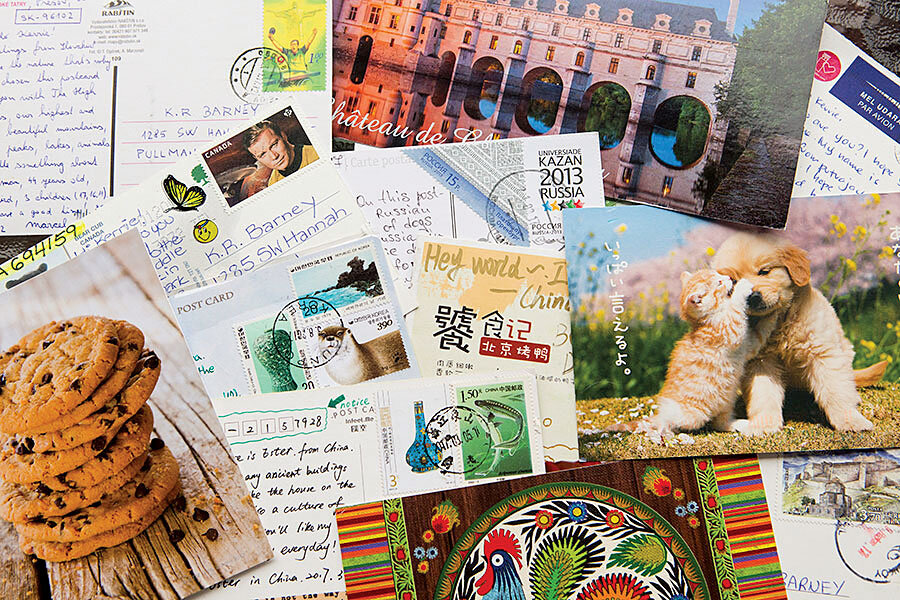Postal diplomacy
Loading...
One of my favorite hobbies is exchanging old-fashioned, paper-with-a-stamp-on-it postcards with random strangers around the world. And for me, it’s sending not just any postcard, but one in particular that seems to resonate with people everywhere.
Here’s how it works: The Postcrossing project was created by Paulo Magalhães in 2005, when he was a student in Portugal. He liked getting mail – especially postcards. He thought others did, too – but how could he connect with them? That’s when he came up with the idea of an online platform (Postcrossing.com): There, postcard lovers like me can sign up to send a postcard to someone who has registered online, and receive a postcard in return. The 1 millionth postcard was exchanged in 2008. This past winter, the 40 millionth was mailed.
Along with a randomly selected address, participants get a unique code to put on the postcard. When the postcard arrives, the recipient registers that code with the site, which then causes the sender’s address to be given to another Postcrosser in turn. In practice, this means that for nearly every postcard I send (a few get lost in the mail) I get one back. And since I never know who will be sending me a card or where in the world they live, every trip to the mailbox holds the potential for a wonderful surprise.
Privacy-conscious Americans might worry about sharing their address with strangers overseas. So did I, at first. I used a post office box and an assumed name. It didn’t take me long, though, to decide not to bother. Almost without exception, Postcrossers are friendly, polite, respectful folks – in more than 450 cards exchanged, I’ve yet to have a bad experience.
On days when the international news is depressing, Postcrossing is my solace. There’s nothing like getting a card from a child in China just learning to write in English, or a grandmother in Belarus describing her most recent gardening success to remind me that we truly are members of one global family, far more similar than we are different. It makes me feel as though the peaceful world I dreamed of as a teenager might still be within reach.
At last count, there were more than 690,000 Postcrossers in 211 countries, representing nearly every race, religion, and creed on the planet – and the cards they’d like to receive are nearly as diverse. I’ve seen requests for postcards featuring maps, wombats, Benedict Cumberbatch, and the color green. But no matter how lengthy or outlandish a particular Postcrosser’s list of requests may be, somewhere, in nearly every profile, is a sentence like this: “Please send me a card that represents something unique or special about your country.”
I love to see that request. To me, the opportunity to share what I love most about my country and to learn what other people love most about theirs is the heart and soul of this endeavor. But it’s a tall order. How does one choose a postcard that best represents the United States, especially in these troubled times?
I’ve tried many things. I’ve sent postcards of historical monuments, vistas from national parks, flags and fireworks, and even a few Hollywood celebrities. All were received with well-mannered thanks. I didn’t get any real enthusiasm until I began sending out one card in particular: a photo of chocolate chip cookies. (See inset.)
The positive response to this simple card astonished me. Instead of polite messages of thanks, I was regaled with postcards punctuated with smiley
faces and personal stories. Many non-
Americans, it seems, have experienced the genuine, baked-with-love-at-home American chocolate chip cookie at some point, and their memory of it is warm and vivid.
One German Postcrosser, who first tasted the cookies when she was in the US as a teenage au pair, wrote that she loved them so much that, 15 years later, she still has a dear American friend mail her a batch every Christmas. “I’ve tried to make them myself here in Germany,” she wrote, “but they are never quite the same. There’s something about a chocolate chip cookie made in America, with American ingredients, that’s very special.”
It seems like such a trivial thing, sending out a postcard of chocolate chip cookies and receiving a fond memory in return. But as travel and communication technology continue to shrink the world, it’s important to remember that it isn’t just for diplomats and politicians to represent our country anymore. All of us have the power – and perhaps the responsibility – to be ambassadors, to show the best of America to the world.
And it’s good to know that what you need to accomplish this is not necessarily complicated or expensive. It can be as simple as a postcard. And as sweet as a chocolate chip cookie.
The postcards above are from the author’s collection. For more information, go to Postcrossing.com.







